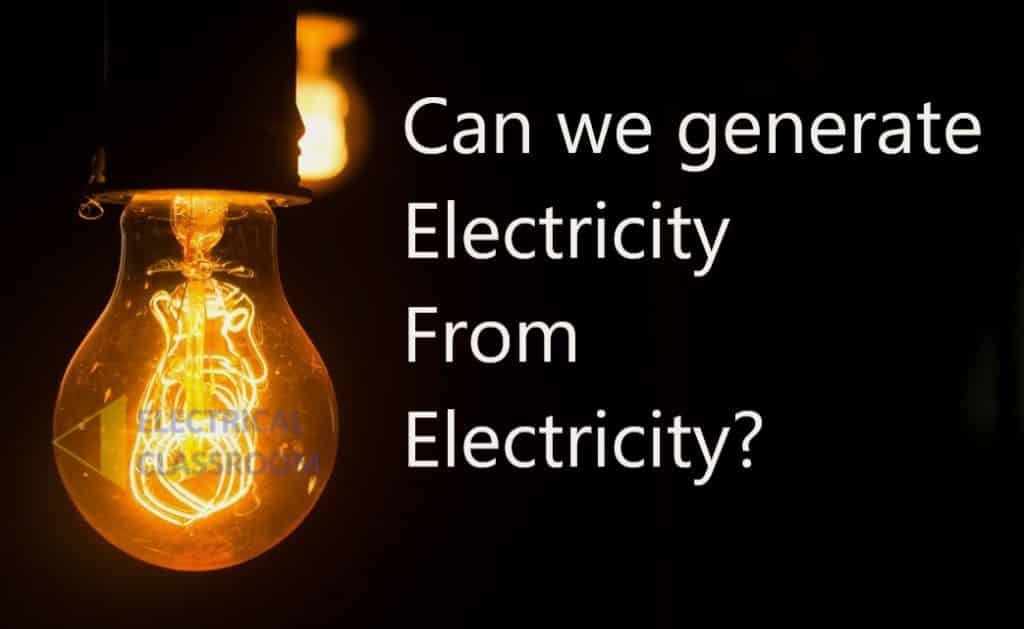
“Can we generate electricity from electricity?” This is a quite common question that many people ask. The answer for this question is amazingly simple but tricky. We need to understand the principle of energy transformation to be able to digest the answer.
According to the law of conservation of energy, “Energy can neither be created nor be destroyed. But it can be transferred or transformed from one form to the other.” The total energy in the universe is always constant. For example, we can generate electricity by burning fossil fuels, convert the light energy from the Sun to electricity by using photo-voltaic cells, by using hydro energy to move the turbine coupled to an electric generator or use a wind turbine to generate electricity. But we cannot bring electric energy from “nowhere”.
How can we generate electricity from electricity? Is that even possible?
The answer is: “Yes”. But we end up spending more electricity than we generate.
If you are thinking of generating electricity by coupling an electric motor to a generator or dynamo or an alternator, you must keep in mind that every electric machine or circuit has a certain amount of power loss. The electric motor, you use to drive the generator consumes power. A certain amount of power is lost in the form of heat and noise (copper loss and iron loss), and leakage inductance in the motor before the applied electricity is transferred to its rotor in the form of mechanical energy (torque). Also, some amount of energy is lost in the rotor due to friction in the bearing
Therefore,
The power transferred to the rotor = Power Supplied – (Stator losses + Rotor Losses)
Pm=PI – (PSM + PRM)
Where,
Pm – Mechanical power delivered by the motor shaft
PI – Power consumed by the motor
PSM – Stator Power loss
PRM – Rotor power loss
Now lets come to the generator side. As the motor rotates the shaft of the generator, some amount of energy is lost because to friction on the generator shaft, some on the winding and the remaining power is transferred to the output terminals of the generator.
Hence,
Power transferred to the generator terminal = Rotor power – (Rotor losses + stator losses in generator)
PG= Pm – (PSG + PRG)
Where,
PG – Power delivered by the generator
Pm – Mechanical power by the motor
PSG – Power lost in the generator’s stator
PRG – Power lost in the generator’s rotor
From the above equations:
PG= PI – (PSM + PRM + PSG + PRG)
From the above equation it is clear that the power generated by the generator will be lesser than the power consumed by the motor. Hence, in this case instead of generating power we are losing it.
Let us assume that we have a 100kW induction motor with an efficiency of 95% coupled to a generator rated 100kW with an efficiency of 92%. Then,
The maximum mechanical power delivered by the motor to the generator = 95% of 100kw = 95kW
The maximum electrical power delivered by the generator = 92% of 95kW = 87.4kW
Therefore, if we couple a 100kW motor to a 100kW generator, we can generate 87.4kW of power i.e. 12.6kW lesser than the power consumed by the motor.
Transformation of electricity from one form to the other
To convert AC to DC or vice versa, rectifiers and inverters can be used. These semiconductor-based circuits can convert electricity from one form to other at a minimum power loss. Also, if you want to alter voltage levels, transformers can be used.
Asynchronous generators
When you spin an induction motor at a speed higher than it synchronous speed, it acts as an asynchronous generator. These generators are used in mini hydro-power plants and wind turbines.
Bottom Line
If you try to generating electricity by coupling a motor to a generator, you end up wasting energy instead of generating it.
Hope you got the answer for you question. If you still believe that you can generate electricity from electricity or if you know a technique to do so let us know in the comment section below.